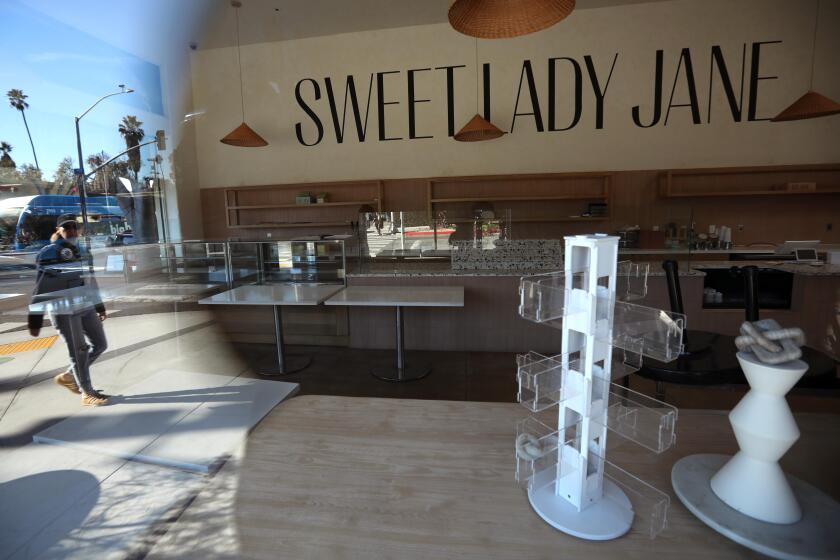Most of Cocoanut Grove to be razed
Delivering yet another blow to historical preservationists, the Los Angeles Board of Education decided Tuesday to tear down most of the structure of the Cocoanut Grove nightclub at the former Ambassador Hotel as part of its plans to build a school there. Officials said testing determined that the structure was too weak to withstand an earthquake.
Neighborhood activists, who have been waiting for the K-12 campus for years, applauded after the speedy 7-0 vote, which followed very little discussion by board members.
“It’s been such a long process to get to where we are. We’re talking years and years and years,” said Sherly Chavarria, director of education and technology programs for the Central American Resource Center, who appeared at Tuesday’s meeting to support the changes. “The fear was that perhaps time would be taken to revise the plan, to analyze other options for the Cocoanut Grove.”
But the Los Angeles Conservancy, one of a number of groups that were embroiled in a failed legal battle against the district to block the hotel’s destruction, said the board broke its promise to the community.
“In my mind, this issue is really probably more about accountability for LAUSD -- that if you say you’re going to do something, you do it -- than the nitty-gritty of what are the issues of preservation of the Cocoanut Grove,” said Linda Dishman, executive director of the conservancy. “We’ll be talking to our lawyers.”
In the meantime, the district will move ahead with its $341-million plan to build an elementary, middle and high school that will house 4,240 students on the 24-acre property. Demolition of the three-quarters of the Cocoanut Grove is slated for next month. Current plans call for completion of the K-3 building in 2009 and the remainder in 2010.
The district bought the site of the fabled 1921 hotel -- where presidents and politicians rubbed elbows with Hollywood celebrities -- in bankruptcy court in 2001 with grand plans to build a sprawling campus. By then, the hotel was dilapidated, having been closed for more than a decade.
In a state-mandated environmental impact report, the district acknowledged that the property was historically significant. To mitigate the impact of tearing most of it down, L.A. Unified said it would preserve the pantry where Robert F. Kennedy was assassinated in 1968 and keep the Cocoanut Grove, home to six Academy Awards shows, turning it into a high school auditorium.
In public statements and during court proceedings, the district said it would cut out the pantry and preserve it whole. Officials said those plans were based on a review of blueprints and visual inspection of the site.
But under current plans, only the east wall, the circular entry and a portion of the glass west wall of the nightclub and historic Paul Williams cafeteria will not be destroyed, along with some interior features that were removed and will be incorporated into the design. As for the pantry, L.A. Unified decided in 2005 that the district would collect 29 items from it -- mostly doors, electrical items and an ice machine -- put them in storage, and tear down the rest of it.
“Maybe it’s not the ending everyone would have hoped for, but it’s the ending that we’re at because of the poor structural condition,” said John Kuprenas, a consultant who is overseeing the construction of the school for the district. “We had to change our plan.”
According to a supplemental environmental impact report approved by the board Tuesday, testing found that the concrete connections were inadequate and the cement content and strength of the concrete were too low in most of the Cocoanut Grove.
Shoring the walls would take up so much space that ceilings would be low and hallways too narrow for the area to be functional, said Jim Cowell, the outgoing head of new construction for the district. Instead, the district will tear down the concrete walls and build new ones in the same place, move the stage and slope the floor, so the nightclub can work as an auditorium. The east wing was stronger than the rest of the building, so the structural elements there will be maintained.
The cost will remain the same, according to the district.
Dishman disputed that the decision was based on significantly new information, arguing that the district knew the concrete was weak years ago and that’s why it said it had to tear down the hotel. She also accused the board of failing to follow state law when it decided not to reopen the environmental review, voting to keep only portions of the pantry, rather than the whole room, as initially promised.
“They’re saying: We don’t want to do this. We want to replicate it. Our concern about replication is that it’s not historic preservation. It’s not a mitigation measure for mitigation of a historic resource,” she said.
Kevin Reed, the district’s general counsel, said that because the pantry was still being preserved, a change in the method of doing so was not enough to trigger further environmental review. As far as the nightclub is concerned, he said that was a deviation from the plan, and the board’s action Tuesday was the proper way to handle it.
“The district adhered to the process,” Reed said.
But one board member, Marguerite Poindexter LaMotte, expressed concerns about the accusations.
“Very serious allegations have been made about the district regarding its credibility,” she said, asking Reed to explain whether the district was going back on its promises to preservationists.
Reed replied that keeping the Cocoanut Grove intact was a “hope,” not a promise.
Kuprenas, the project manager, said that not all the news was bad after workers tore open the building during demolition. The original pylon sign was discovered under a 1970s version, allowing the district to re-create the entrance to the hotel.
--
More to Read
Sign up for Essential California
The most important California stories and recommendations in your inbox every morning.
You may occasionally receive promotional content from the Los Angeles Times.






